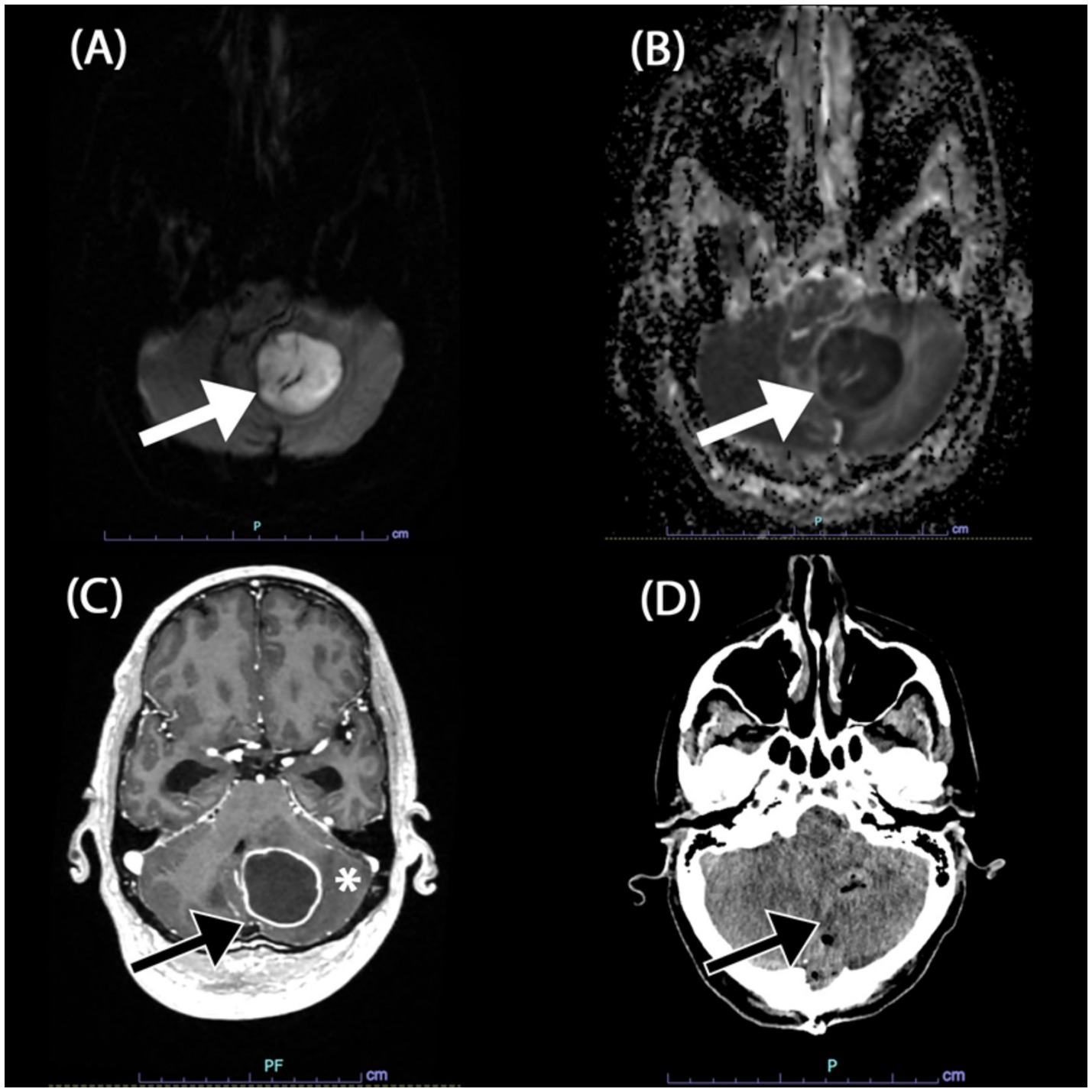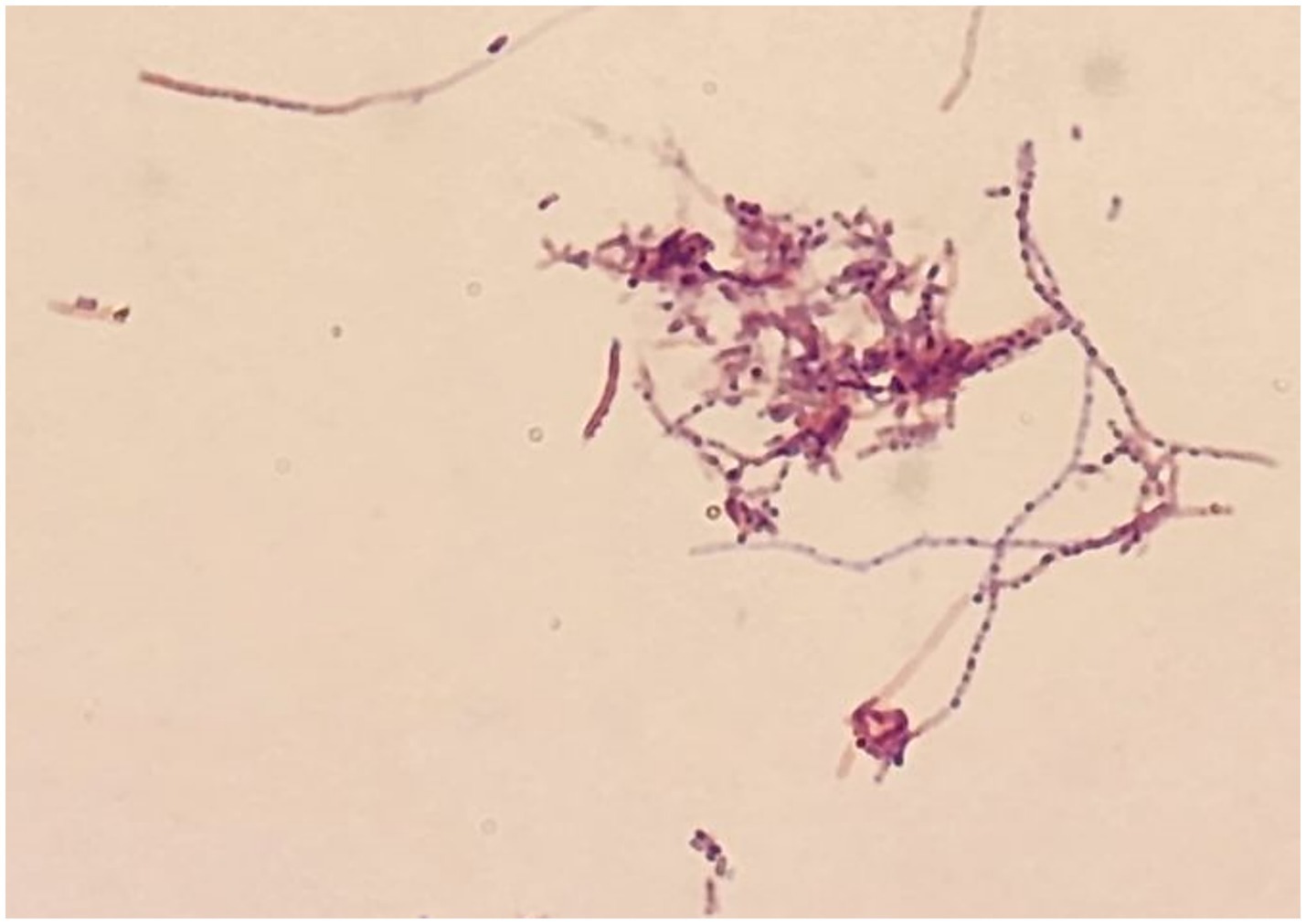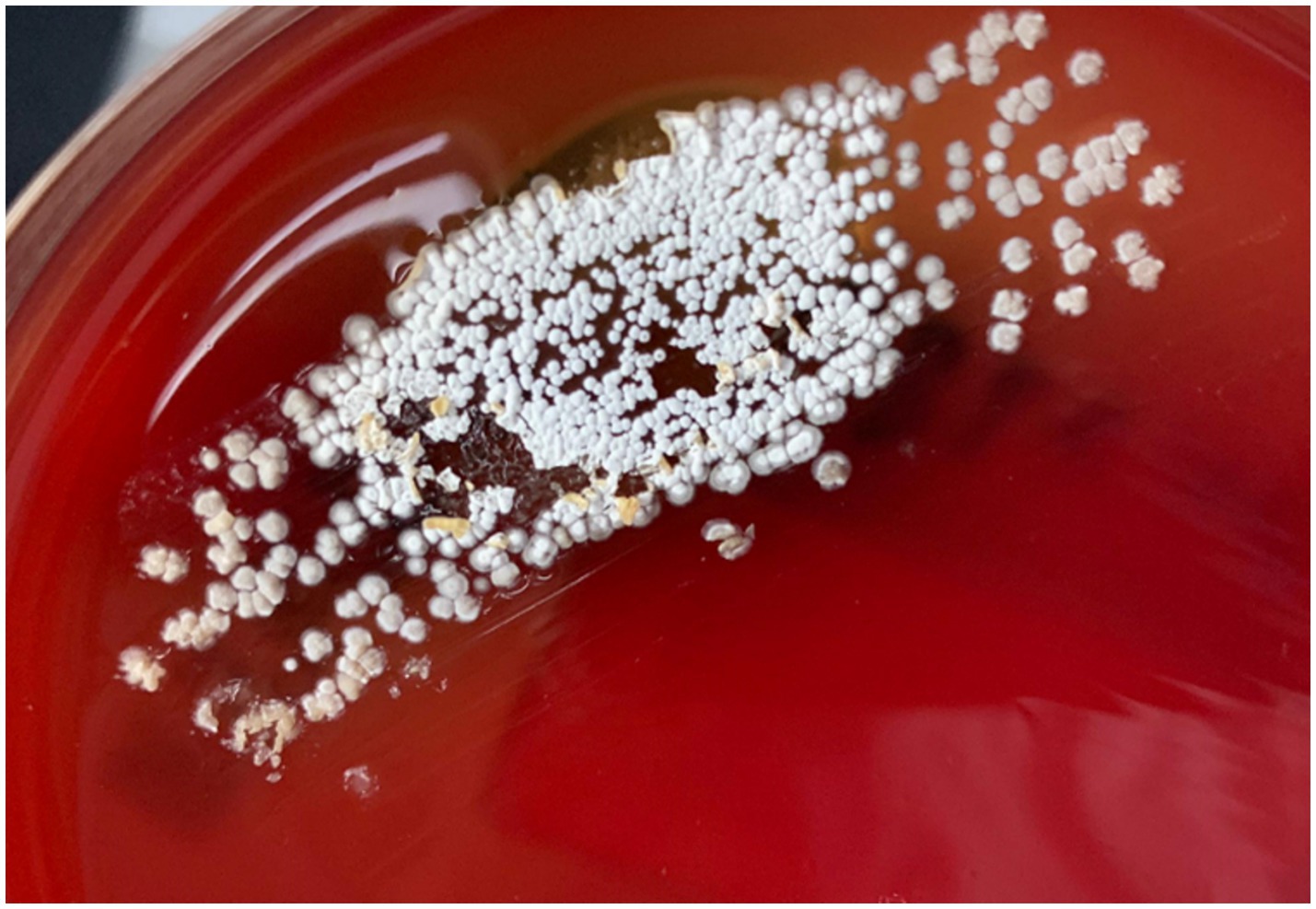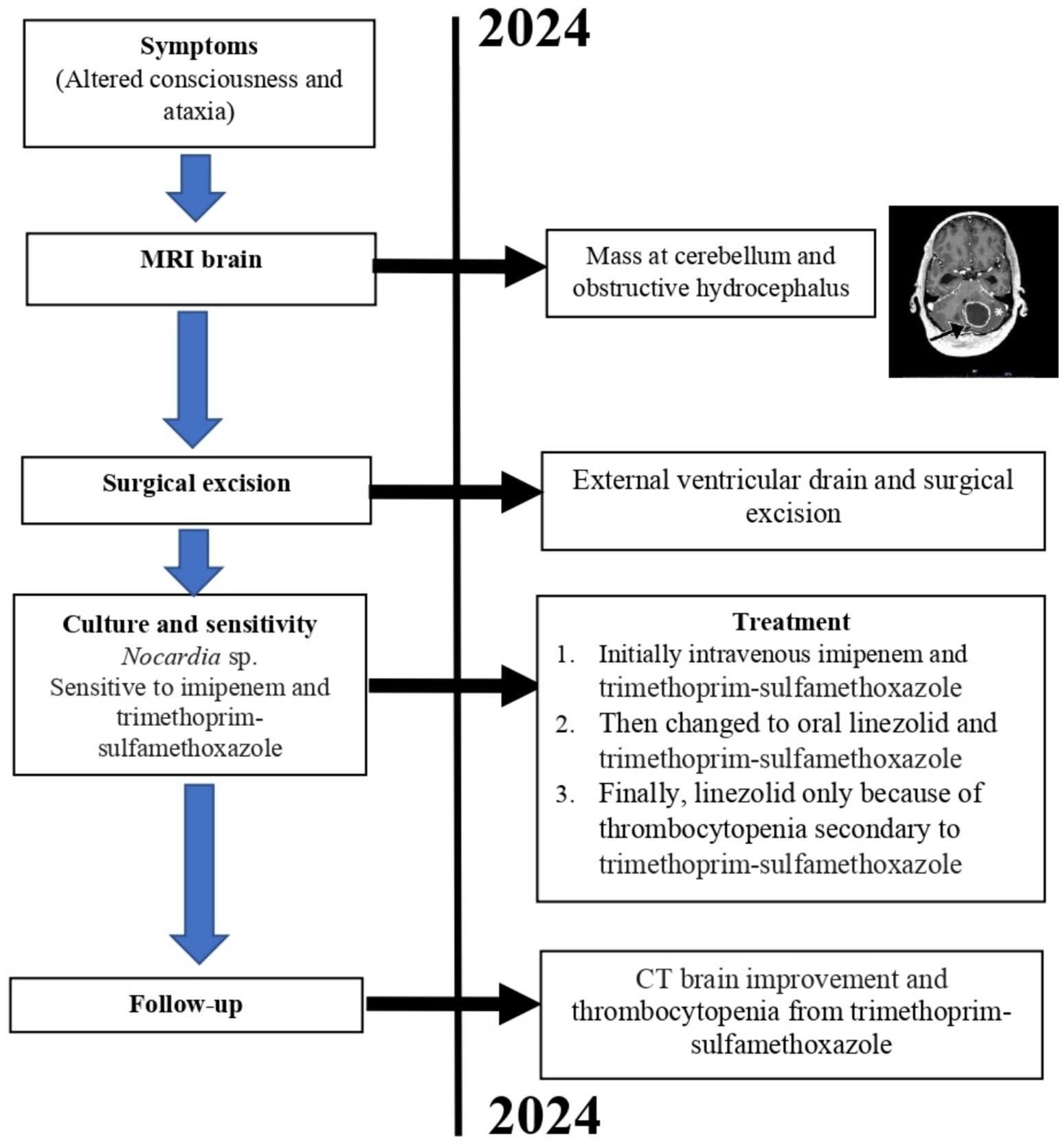- 1Department of Anaesthesiology and Intensive Care, Faculty of Medicine, Univerisiti Kebangsaan Malaysia, Kuala Lumpur, Malaysia
- 2Department of Medical Microbiology and Immunology, Faculty of Medicine, Universiti Kebangsaan Malaysia, Kuala Lumpur, Malaysia
- 3Department of Radiology, Faculty of Medicine, Universiti Kebangsaan Malaysia, Kuala Lumpur, Malaysia
Introduction: Central nervous system (CNS) nocardiosis is a rare but lethal opportunistic infection, presenting a formidable diagnostic and therapeutic challenge, especially in immunocompromised populations. The most common presentation is a cerebral abscess.
Case presentation: We report the case of a 53-year-old male with a history of relapsed and refractory multiple myeloma who presented with an acute change in mental status and ataxia. Initial clinical suspicion centered on a posterior circulation ischemic event. However, magnetic resonance imaging (MRI) revealed a large, rim-enhancing cerebellar mass with associated obstructive hydrocephalus. The patient underwent surgical excision of the lesion, and subsequent microbiological culture confirmed an abscess caused by a Nocardia species. He was treated with a prolonged course of targeted antimicrobial therapy, including intravenous imipenem, followed by oral linezolid and trimethoprim-sulfamethoxazole. At the 3-month outpatient follow-up after discharge, the patient was found to have thrombocytopenia, attributed to the side effects of oral trimethoprim-sulfamethoxazole. Treatment was subsequently maintained with oral linezolid 600 mg for 1 year. Despite improvement of the abscesses, the patient ultimately succumbed to the progression of his long-standing multiple myeloma.
Conclusion: This case underscores the importance of including uncommon opportunistic pathogens like Nocardia in the differential diagnosis of CNS lesions in immunocompromised patients. A definitive diagnosis via microbiological analysis of tissue specimens is imperative to guide appropriate antimicrobial therapy and achieve a favourable clinical outcome.
Introduction
The genus Nocardia comprises a diverse group of aerobic, gram-positive, weakly acid-fast bacilli that form characteristic branching filaments (1). These organisms are ubiquitous in the environment but are an infrequent cause of human disease. The taxonomy of the genus is complex and continuously evolving, with numerous species now recognized as clinically significant, which complicates identification efforts (2, 3). When nocardiosis occurs, it can manifest as a severe localized or disseminated process. The primary route of acquisition is typically via inhalation, leading to pulmonary disease with potential for subsequent hematogenous dissemination to other organ systems (4, 5). The central nervous system CNS is the most common site of extrapulmonary disease, affecting a significant proportion of patients with systemic nocardiosis (6, 7).
The diagnosis of CNS nocardiosis is often challenging due to its nonspecific clinical and radiological features, which can mimic other pathologies such as infectious etiologies, or more notably, metastatic brain tumors (6, 8). Immunocompromised individuals represent the highest-risk population, with corticosteroid use being a common predisposing factor (7, 9). This highlights the need for a high index of suspicion in this vulnerable patient group.
We present a compelling case of a patient with a history of multiple myeloma who developed a Nocardia cerebellar abscess. This case highlights the diagnostic difficulties of such a presentation and emphasizes the necessity of considering rare opportunistic pathogens in patients with a compromised immune system.
Case presentation
A 53-year-old male with a five-year history of relapsed and refractory immunoglobulin A kappa (IgAκ) multiple myeloma presented with an acute change in mental status and profound instability, specifically altered consciousness and ataxia with no other cerebellar signs. The patient was also noted to be semi-dependent in his activities of daily living. His medical history was notable for multiple lines of therapy for the kappa (IgAκ) multiple myeloma, including proteasome inhibitors, immunomodulatory drugs, and an autologous stem cell transplant. His course had been complicated by numerous sequelae, including pathological fractures, hypercalcemia-induced delirium, acute kidney injury, and neutropenic sepsis. At the time of presentation, he was receiving a salvage regimen of daratumumab, pomalidomide, and dexamethasone.
The initial symptoms of altered consciousness and ataxia were attributed to a presumed posterior circulation ischemic event. A magnetic resonance imaging (MRI) revealed a large, 3.4 × 3.5 × 3.2 cm mass in the left cerebellum (Figures 1A–C), which exhibited restricted diffusion and rim enhancement. The mass was exerting a significant effect on the fourth ventricle, resulting in obstructive hydrocephalus. The leading differential diagnoses at this juncture were CNS lymphoma and a cerebellar abscess. Diffusion-weighted imaging (DWI) was also performed (Figures 1A,B) and showed findings that were most suggestive of an abscess.

Figure 1. Magnetic resonant imaging (MRI) of the brain in axial views. (A,B) DWI b1000 and ADC showed restricted diffusion of the mass in the left cerebellum (white arrow). (C) Post-gadolinium contrast T1-weigted image revealed rim enhancing component of the mass (black arrow) associated with surrounding oedema (*). Note the compression onto the fourth ventricle causing obstructive hydrocephalus (not shown). (D) Post-operative non-contrasted computed tomography (CT) of the brain in axial view revealed the post operative air locules (black arrow) in the left cerebellum without bleed and resolution of fourth ventricle compression.
A right-sided external ventricular drain (EVD) was placed to treat the obstructive hydrocephalus. Cerebrospinal fluid (CSF) analysis revealed a high opening pressure but was otherwise unremarkable, with low protein (<68 mg/L), elevated glucose (5.04 mmol/L), and negative cultures. Forty-eight hours after EVD placement, the patient underwent surgical excision of the cerebellar lesion. Intraoperatively, the mass was noted to be encapsulated and rubbery, containing a yellowish, caseous material. A definitive diagnosis was established by the microbiology laboratory, where cultures of the abscess material yielded Nocardia species (Figures 2, 3). The isolate demonstrated sensitivity to imipenem and trimethoprim-sulfamethoxazole (cotrimoxazole).

Figure 2. Microscopic examination of the excised cerebellar lesion showing branching, filamentous Gram-positive bacteria consistent with Nocardia species (Gram stain, 1,000× magnification).

Figure 3. Culture of the excised lesion on blood agar demonstrating the characteristic dry, chalky, white-tan colonies of Nocardia species.
The patient’s postoperative course was managed in the intensive care unit (ICU). An extensive evaluation for other concurrent infections, including serial blood cultures and a comprehensive panel of serologies, was negative. A non-contrasted CT brain did not show any significant bleed and resolved obstructive hydrocephalus (Figure 1D). A CT scan of the chest, abdomen, and pelvis revealed findings consistent with ventilator-associated pneumonia but no definitive primary focus of nocardiosis.
His antimicrobial regimen was initiated with intravenous imipenem 500 mg four times daily for 28 days and intravenous trimethoprim-sulfamethoxazole for 13 days. He was subsequently transitioned to a long-term oral regimen of oral linezolid 600 mg twice daily and oral trimethoprim-sulfamethoxazole two tablets a day twice weekly for a total duration of 1 year.
Over the ensuing weeks, the patient exhibited a steady and significant neurological recovery. His level of consciousness, coordination, and speech gradually returned to his functional baseline. A follow-up CECT brain one-month post-surgery demonstrated a marked reduction in the size of the cerebellar lesion at 1.5 × 2.4 × 2.4 cm (previously 3.4 × 3.5 × 3.2 cm) with a lesser degree of mass effect. He was ultimately discharged in a stable condition to complete his extended course of antibiotic therapy as an outpatient.
During the outpatient clinic visits after 3 month being discharged, patient was found to have thrombocytopenia and was attributed to a side effect of oral trimethoprim-sulfamethoxazole and the treatment was only maintained with oral linezolid 600 mg for one-year duration. Patient condition of consciousness, coordination, and speech has significant improvement. Six months after the procedure, patient developed recurrence of multiple myeloma but opted for palliative care and refused reinduction of chemotherapy. Despite improvement of the abscesses, the patient succumbed due to progression of his long-standing multiple myeloma. The clinical timeline of the patient progression in shown in Figure 4.
Discussion
This case provides a compelling illustration of a rare but critical opportunistic infection in an immunocompromised patient. The patient’s underlying multiple myeloma and extensive treatment history created a state of profound T-cell-mediated immune deficiency, which is the quintessential risk profile for invasive nocardiosis, particularly with the use of newer agents (10, 11). The pathogenesis of nocardial dissemination to the CNS is facilitated by specific virulence factors, which allow the organism to evade phagocytic killing and promote hematogenous seeding of the brain (4).
The diagnostic journey in this case highlights several classic challenges of CNS nocardiosis. The initial misdiagnosis of a stroke is a common pitfall, driven by the nonspecific and often insidious onset of neurological symptoms, which can lead to critical delays in appropriate treatment (7). Furthermore, the neuroimaging finding of a ring-enhancing lesion, while suggestive of an abscess, is not pathognomonic and shares features with high-grade neoplasms and other infections, making a definitive radiological diagnosis challenging (6, 8). The patient’s clinical presentation, combined with the presence of multiple myeloma, placed CNS lymphoma high on the list of differential diagnoses. The definitive diagnosis was only established through surgical excision of the lesion, which confirmed the presence of a pyogenic abscess and, importantly, yielded cultures positive for Nocardia sp.
A crucial diagnostic principle underscored by this case is the low utility of CSF analysis for encapsulated brain abscesses. The negative CSF cultures are consistent with the literature, where the diagnostic yield of CSF is reported to be low in the absence of concomitant meningitis (7, 12, 13). This emphasizes that for a patient with a suspected nocardial abscess, a lumbar puncture is an insufficient diagnostic step, and clinical efforts must be aggressively directed toward obtaining a tissue specimen. Direct aspiration or excision of the lesion remains the gold standard for diagnosis, as it provides the highest yield for both histopathology and, critically, culture for antimicrobial susceptibility testing (7, 14). The extended time required for culture results creates a diagnostic-therapeutic gap where empirical therapy must be initiated without definitive susceptibility data.
The successful outcome in this patient was predicated on a multimodal therapeutic strategy that combined aggressive neurosurgical intervention with prolonged, targeted antimicrobial therapy (7, 14, 15). This combined approach is consistently associated with the best survival rates in CNS nocardiosis. Surgical intervention was vital not only for establishing the diagnosis but also for source control, reducing the intracranial mass effect, and decompressing the obstructed ventricular system.
The antimicrobial regimen was designed based on established principles for treating severe nocardiosis. The initial use of combination intravenous therapy with imipenem and trimethoprim-sulfamethoxazole is a standard approach, though more recent data suggest a trend toward using combinations with better CNS penetration (4, 7, 16). In this case, the regimen was complicated by the patient’s reaction to trimethoprim-sulfamethoxazole leading to thrombocytopenia, which necessitated a switch to oral Linezolid-based regimen only. This highlights the practical challenges of managing long-term antimicrobial therapy in a critically ill and immunocompromised patient. The transition to a long-term oral regimen containing linezolid is also consistent with current evidence. Linezolid offers excellent oral bioavailability and CNS penetration and has near-universal in vitro activity against Nocardia species, making it a cornerstone of modern therapy, particularly when prolonged treatment is required (4, 17, 18). The planned one-year duration of therapy is appropriate for CNS disease in an immunocompromised host, as shorter courses are associated with a higher risk of relapse (7). This extended duration, however, necessitates vigilant monitoring for potential toxicities, particularly the myelosuppression and neuropathy associated with long-term linezolid use (19, 20).
Although the abscess resulting from nocardiasis was managed successfully with the antibiotic regimen, the progression of his multiple myeloma prevented us from completing the planned one-year course of treatment.
Conclusion
CNS nocardiosis remains a significant diagnostic and therapeutic challenge that requires a high index of suspicion, particularly in patients with profound immunosuppression. This case highlights the classic pitfalls in diagnosis, including non-specific clinical and radiological presentations, and reinforces the principle that a definitive diagnosis requires direct tissue sampling. An optimal outcome is contingent upon an aggressive, multidisciplinary approach that combines prompt neurosurgical intervention for source control with a prolonged course of targeted, multi-drug antimicrobial therapy guided by susceptibility testing and any adverse reaction related to the treatment.
Data availability statement
The raw data supporting the conclusions of this article will be made available by the authors, without undue reservation.
Ethics statement
The studies involving humans were approved by Research Ethics Committee National University of Malaysia. The studies were conducted in accordance with the local legislation and institutional requirements. The participants provided their written informed consent to participate in this study. Written informed consent was obtained from the individual(s) for the publication of any potentially identifiable images or data included in this article.
Author contributions
IA: Writing – review & editing, Writing – original draft. MM: Writing – original draft, Writing – review & editing. CD: Conceptualization, Writing – original draft. MA: Writing – review & editing, Investigation. FA: Formal analysis, Writing – original draft, Supervision. YS: Project administration, Methodology, Writing – review & editing. AZ: Validation, Writing – review & editing, Visualization, Resources.
Funding
The author(s) declare that no financial support was received for the research and/or publication of this article.
Conflict of interest
The authors declare that the research was conducted in the absence of any commercial or financial relationships that could be construed as a potential conflict of interest.
Generative AI statement
The authors declare that no Gen AI was used in the creation of this manuscript.
Any alternative text (alt text) provided alongside figures in this article has been generated by Frontiers with the support of artificial intelligence and reasonable efforts have been made to ensure accuracy, including review by the authors wherever possible. If you identify any issues, please contact us.
Publisher’s note
All claims expressed in this article are solely those of the authors and do not necessarily represent those of their affiliated organizations, or those of the publisher, the editors and the reviewers. Any product that may be evaluated in this article, or claim that may be made by its manufacturer, is not guaranteed or endorsed by the publisher.
References
1. Palomba, E, Liparoti, A, Tonizzo, A, Castelli, V, Alagna, L, Bozzi, G, et al. Nocardia infections in the immunocompromised host: a case series and literature review. Microorganisms. (2022) 10:1120. doi: 10.3390/microorganisms10061120
2. Duggal, SD, and Chugh, TD. Nocardiosis: a neglected disease. Med Princ Pract. (2020) 29:514–23. doi: 10.1159/000508717
3. Mehta, HH, and Shamoo, Y. Pathogenic Nocardia: a diverse genus of emerging pathogens or just poorly recognized? PLoS Pathog. (2020) 16:e1008280. doi: 10.1371/journal.ppat.1008280
4. Lafont, E, Conan, PL, Rodriguez-Nava, V, and Lebeaux, D. Invasive nocardiosis: disease presentation, diagnosis and treatment—old questions, new answers? Infect Drug Resist. (2020) 13:4601–13. doi: 10.2147/IDR.S249761
5. Terlizzi, V, Ballerini, T, Castaldo, A, Dolce, D, Campana, S, Taccetti, G, et al. Clinical features and outcomes of persons with cystic fibrosis and Nocardia isolation: a systematic review. BMC Pulm Med. (2024) 24:440. doi: 10.1186/s12890-024-03217-0
6. Meena, DS, Kumar, D, Bohra, GK, Midha, N, and Garg, MK. Clinical characteristics and treatment outcome of central nervous system nocardiosis: a systematic review of reported cases. Med Princ Pract. (2022) 31:333–41. doi: 10.1159/000525509
7. Sun, H, Goolam Mahomed, M, and Patel, J. Brain metastasis or nocardiosis? A case report of central nervous system nocardiosis with a review of the literature. J Community Hosp Intern Med Perspect. (2021) 11:258–62. doi: 10.1080/20009666.2021.1877399
8. Song, J, Dong, L, Ding, Y, and Zhou, J. A case report of brain abscess caused by Nocardia farcinica. Eur J Med Res. (2021) 26:83. doi: 10.1186/s40001-021-00562-2
9. Bonifaz, A, García-Sotelo, RS, Lumbán-Ramirez, F, Vázquez-González, D, Inclán-Reyes, JI, Sierra-Garduño, ME, et al. Update on actinomycetoma treatment: linezolid in the treatment of actinomycetomas due to Nocardia spp and Actinomadura madurae resistant to conventional treatments. Expert Rev Anti-Infect Ther. (2025) 23:79–89. doi: 10.1080/14787210.2024.2448723
10. Sayer, K, Abousedu, YAI, Ghanem, OM, Doghaim, M, and Sayer, F. Brain abscesses caused by Nocardia farcinica in a 44-year old woman with multiple myeloma: a rare case and review of the literature. Am J Case Rep. (2022) 23:e937952. doi: 10.12659/AJCR.937952
11. Kim, S, Shi, HJ, Jeon, CH, Kim, SB, Yi, J, Kim, AR, et al. Clinical characteristics of nocardiosis: a multicenter retrospective study in Korea. Infect Chemother. (2023) 55:431–40. doi: 10.3947/ic.2023.0032
12. Waked, R, Tarhini, H, Mansour, H, Saliba, G, Chehata, N, Chedid, M, et al. A case series of brain abscesses: an eleven-year retrospective single center study. J Infect Dev Ctries. (2021) 15:791–7. doi: 10.3855/jidc.12816
13. Bodilsen, J, D’Alessandris, QG, Humphreys, H, Iro, MA, Klein, M, Last, K, et al. European society of clinical microbiology and infectious diseases guidelines on diagnosis and treatment of brain abscess in children and adults. Clin Microbiol Infect. (2024) 30:66–89. doi: 10.1016/j.cmi.2023.08.016
14. Larrañaga Lapique, E, Gallemaers, S, Schuind, S, Mabiglia, C, Yin, N, Martiny, D, et al. Successful treatment of brain abscess caused by Nocardia farcinica with combination therapy despite discrepancies in in vitro results: a case report and review of diagnostic and therapeutic challenges. Microorganisms. (2025) 13:1536. doi: 10.3390/microorganisms13071536
15. Chen, LD, Li, HY, Xie, JJ, Hu, MF, Chen, XX, Cai, ZM, et al. Clinical characteristics and outcome analysis of pulmonary nocardiosis in southern China: a two-center retrospective study. BMC Infect Dis. (2024) 24:1073. doi: 10.1186/s12879-024-09933-6
16. Davidson, N, Grigg, MJ, Mcguinness, SL, Baird, RJ, and Anstey, NM. Safety and outcomes of linezolid use for nocardiosis. Open Forum Infect Dis. (2020) 7:ofaa090. doi: 10.1093/ofid/ofaa090
17. Wang, T, Zhang, H, Feng, R, Ren, J, Xu, X, and Sun, S. The in vitro antimicrobial activity of linezolid against unconventional pathogens. PeerJ. (2025) 13:e18825. doi: 10.7717/peerj.18825
18. Ma, A, Dong, M, Cheng, J, Liao, X, Dong, W, Liu, C, et al. Clinical efficacy and safety of linezolid in intensive care unit patients. J Intensive Med. (2023) 3:65–72. doi: 10.1016/j.jointm.2022.05.006
19. Yang, J, Ren, HT, Wang, J, Dong, AY, Chen, YL, Hu, DX, et al. Clinical characteristics, susceptibility profiles, and treatment of nocardiosis: a multicenter retrospective study in 2015–2021. Int J Infect Dis. (2023) 130:136–43. doi: 10.1016/j.ijid.2023.02.023
Keywords: Nocardia , infection, central nervous system, cerebellar mass, intensive care unit
Citation: Azaharuddin I, Mokhtar MN, Ding CH, Azmi MI, Abdullah FH, Su YP and Zainudin A (2025) Nocardia infection: a rare case report of a cerebellar mass. Front. Med. 12:1687102. doi: 10.3389/fmed.2025.1687102
Edited by:
Yuetian Yu, Shanghai Jiao Tong University, ChinaReviewed by:
Khalil Ayadi, University of Sfax, TunisiaCesar Adolfo Nieves Perez, Hospital Ángeles Pedregal, Mexico
Copyright © 2025 Azaharuddin, Mokhtar, Ding, Azmi, Abdullah, Su and Zainudin. This is an open-access article distributed under the terms of the Creative Commons Attribution License (CC BY). The use, distribution or reproduction in other forums is permitted, provided the original author(s) and the copyright owner(s) are credited and that the original publication in this journal is cited, in accordance with accepted academic practice. No use, distribution or reproduction is permitted which does not comply with these terms.
*Correspondence: Mohammad Nizam Mokhtar, ZHJuaXphbUB1a20uZWR1Lm15
 Izzuddin Azaharuddin
Izzuddin Azaharuddin Mohammad Nizam Mokhtar
Mohammad Nizam Mokhtar Chuan Hun Ding
Chuan Hun Ding Mohd Imree Azmi
Mohd Imree Azmi Farah Hanim Abdullah
Farah Hanim Abdullah Yik Peng Su1
Yik Peng Su1